It doesn’t matter if you’re a creative professional who likes working on your own schedule, or a nine to fiver managing highly confidential client accounts; burnouts are a thing! When it comes to artists and creative folk in particular, burnout is sometimes related to a lack of inspiration.
Personally I’ve felt burned out on numerous occasions in my career and have found that there are things we can do to re-inspire ourselves and get those creative juices flowing again. I’m going to share some of those with you here over the course of this blog. Bonus: This is really two blog posts in one, because at the end, I’ll share one final way to stay creative (making prints), that will add a new facet to your art business in the process!
Inspiration for an artist is where all the beautiful and captivating work springs from. Without it, creating becomes a lot harder, if near impossible. How does one overcome the feeling of burnout and proceed to re-inspire? Here are some tips that can help.
At times, amidst a burnout, you might have a fleeting idea when you least expect it. At these times you would probably wish you had your art supplies or tools close by. Well, why can’t you? Keep your basic supplies close at hand. Even when on the go, carry a sketchbook or moleskin. This way, you can catch that fleeting inspiration when it comes and build on it later!
As many artists would know, there are times when a process has you studio-bound for days, if not weeks on end. This is all well and good, however if the walls of your studio start closing in and your feel inspirationally dry ? Get out! Immerse yourself in some spontaneous activity. Hit the city center, go get yourself some ice cream, talk to a stranger. Basically, live a little. Life is full of inspiration and there is no telling where it might come from!
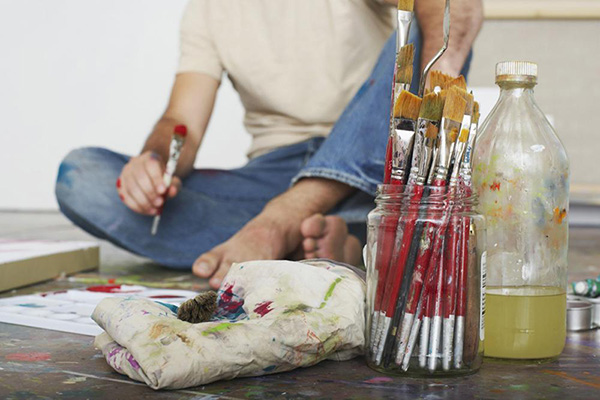 Artist sitting on the floor with their brushes
Artist sitting on the floor with their brushes
At times as artists, we get a little caught up in our technique and pursuing perfection. The trouble with this, is that at times we can become self critical to the point of stagnation. If this is the case with you, and you find yourself shooting down your own work before you even begin, lighten up. Take out your paints or whatever medium you use, and make a mess — on purpose! Have at it. Get the clutter out, and the good ideas will surely flow!
If you’re feeling a little tired of the medium you’re working with, shake things up a bit! Try out another medium or even another art form entirely. Your mind is vast and there will likely be more ways than one to re-spark your creativity. I like to rotate entirely different mediums on a regular basis: ceramic sculpture on day, oil painting the next, and then a quick pencil sketch on the weekend — like this one below, that I drew recently!
 Artist Adesina sketches a young woman with sea green eyes.
Artist Adesina sketches a young woman with sea green eyes.
Observing and taking in other works of art is actually quite inspiring. You might have heard of artistic responses. An artistic response is work done by one artists inspired by the work of another. If you feel you’re running short on inspiration, visit some of the local galleries or connect with other artists to view their work.
You can even look for original artwork for sale, (or prints if you’re on a budget), that you can put up in your own studio, and surround yourself with art to inspire and uplift you! My skull framed art prints (see below) are among my most popular pieces with my fellow artists. And if you’re local, there’s always a lot of brilliant artwork for sale in NY that you could check out and possibly use to re-inspire yourself. I recommend hitting up the galleries down in Chelsea, and once you’ve found something you like, you can wrap up your afternoon with a stroll down the Highline — a perfect close to an inspiring day!
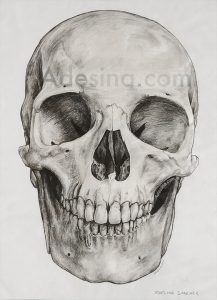
Skull, Poster-size original skull art by Artist Adesina | Buy a Print
Still can’t find that spark of inspiration to create something new? Well, why not re-invent something old? Creating prints out of your favorite pieces of art is a great way to stay productive & creative, without the pressure of having to make new work. And if you plan to eventually license your work for products, a lot of the steps you must undertake to make prints, will help you with that as well.
First, depending on the size & shape of the piece & the size of the prints you want, you’ll have to decide if you want to scan or photograph your work.
Very large pieces, and pieces that have 3D elements, might work out better with photography. Make sure you have good (sunlight or artificial light that is daylight temperature), even lighting, and that there is no glare on your artwork if it’s shiny. When I was creating my skull framed art prints, for example (see below), the graphite was super shiny on camera, and although that was ok for displaying the original piece on my web site, I knew that it would be terrible for prints. So I had to re-take the photo, using indirect lighting that came from several angles: diffuse lighting from a set of large windows in front, and three daylight-temperature photography lights positioned around the room, which I pointed away from the drawing, and bounced off the ceiling and walls. It was quite a setup, but it was really worth it, and saved me so much time later in Photoshop.

Moodily lit photo of Adesina’s original Skull drawing 🙂 — Too much shine for prints!
For photos, also make sure that you are using a good, high-resolution camera; a DSLR is great. Plus, be sure that you are using a lens that minimizes distortion. I personally have an 85mm lens that works well for just about all my medium to large works. I also recommend a tripod, so that your shots are crisp and clear.
For smaller pieces, you should scan them in with a high-resolution scanner (600 dpi or more) that is equipped to handle details. Epson and Canon make excellent scanners that last a long time and have great color fidelity. Alternatively, you can take your work to be scanned commercially, but be prepared to pay for quality. I find that in the long run, it makes more sense to invest in a good quality scanner, than to constantly have to outsource your scanning.
Whether you scan or photograph your work, you should still adjust the images afterward in Photoshop. If you don’t have Photoshop, there are a few other programs that might work, however Adobe PS really is the industry standard and makes this work infinitely easier. I believe a subscription is under $10/month at present for the program, although you should double-check before signing up.
Put your artwork in front of you, and compare it to the image on your computer. Do they match up? For photos, pay special attention to the proportions of the image: are the edges straight? Is the image stretched horizontally or vertically, or are the proportions correct? Use guidelines to help you line things up, and turn on rulers so you can measure. For scans, you may have had to assemble multiple scans into one image using Auto Blend; if so, did the merged result come out correctly, or are there tweaks that you need to make where the layers come together?
Next, look at color. Again, make sure you are looking at your original art in good, even, daylight-temperature lighting, and compare it to what you see on the screen. Do the colors match? Instead of editing the actual pixels, use Adjustment Layers like Hue/Saturation, and Curves, to alter the colors of your work. This way you don’t damage any pixels and can easily reverse any changes you don’t like. Also utilize masks and channels if there are only certain parts, or certain colors, that you want to change. Again, this is preferable over chopping up the actual pixel layers, because a mask is easily removed, and also results in a smaller file when you save the PSD.
Finally, you may need to sharpen your image before printing. Again, you must use your artist’s eye to determine if this step is necessary, but if it is, I recommend using the Smart Sharpen filter; and, if the image is not too big, I also like converting a flattened layer of the finished image into a Smart Layer first and THEN applying the filter. This last step enables you to continue to adjust or remove the filter after applying it.
After you are satisfied with how your digital copy looks, you will have to export a flat copy to print. What format you want to use, depends on what service you will print with. If you are doing professional, limited edition giclee prints, I recommend being in direct contact with the print shop and even sending them the PSD file, to make sure they have exactly what they need. For print on demand services like Zazzle or Fine Art America, check their guidelines on their web site, to see what size and format they need.
Some popular formats for art prints are: Jpeg, Tiff, PDF, EPS.
In the past, print files were usually CMYK, but nowadays, some print services are requesting RGB images, that are normally only reserved for on-screen use. Again, check with the print service you are using, for their requirements.
If you have a good printer at home and are printing yourself, then you might want to experiment to see what gives you the best results. First, check your printer’s instructions to see any recommendations the manufacturer may have regarding art prints, and the type of paper you are using. Secondary to that, in my experience 8 bit Tiff files, at 300 dpi, CMYK, have looked best on my own personal printers.
Once you have exported a flattened version of your image, you’re all set to go! Print it out, or send it to your print service. And of course, don’t forget to update your web site with your new offering! Congrats, you now sell prints :).
There are many other ways for you to get re-inspired. It’s really about getting out there and figuring out what works for you best! As an artist; true inspiration is really within you, it’s just a matter of finding out what helps you connect with it.
Found this article helpful? Then share it using the sharing tools below. Or leave a comment and let me know what tips you are going to use to get your creative juices flowing, or if you have any questions. I love to help my fellow artists succeed!
Be well,
Adesina <3
If you’re someone who has already had work commissioned for you in the past, you’re probably already aware of the process. But for those of you who haven’t, I’m going to elaborate on the process of having an original work of art commissioned for yourself. This is particularly for those who have been wanting to do so for a while and are finally ready to take the first step!
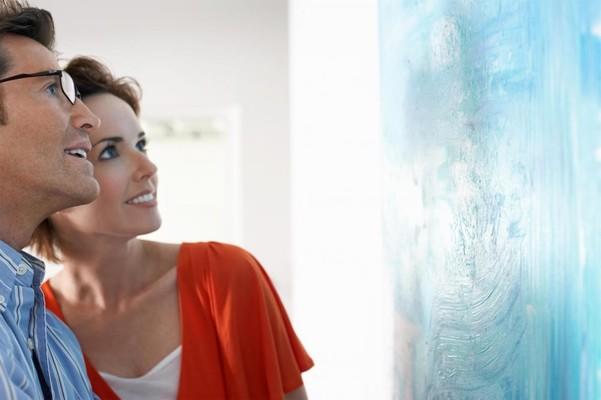
If you are looking to commission a work of art for the first time and are not sure where to start, here’s how you go about it.
The first thing you want to do is choose an artist who you wish to commission. Keep in mind that every artist has their own style and capabilities. To get a good sense of the artist’s style, visit their web site and check out their previous work, like artist Adesina, or any other artist you have in mind.
However, sometimes what’s in an artist’s portfolio, isn’t all they can do. Many artists, especially those just starting out, or who don’t make art full-time, just haven’t yet had the opportunity or time to create work in all the styles that they are capable of. And your commission might just be the chance they were waiting for! So feel free to contact the artist, if you see that they have work that you like, even if it isn’t exactly what you are looking for. This is particularly a good idea, if their existing work is more complex or requires more skill than perhaps you require.
A good example of the above, is a realistic artist who has mostly highly detailed, realistic paintings in their portfolio. If they don’t have a lot of pieces, and/or it looks like they are just starting out, it’s possible that they would like to explore other, simpler/looser styles of painting, but just haven’t done so yet. Or perhaps they already have created works like that, but simply haven’t posted them up on their site yet.
Another good example, is if perhaps you are looking for a sculpture of your pet, and you find a sculptor online who has done a few really great sculptural busts of people. More than likely, if they can realistically sculpt a human being (hair included of course!), they can probably make something beautiful of your furry pet as well.
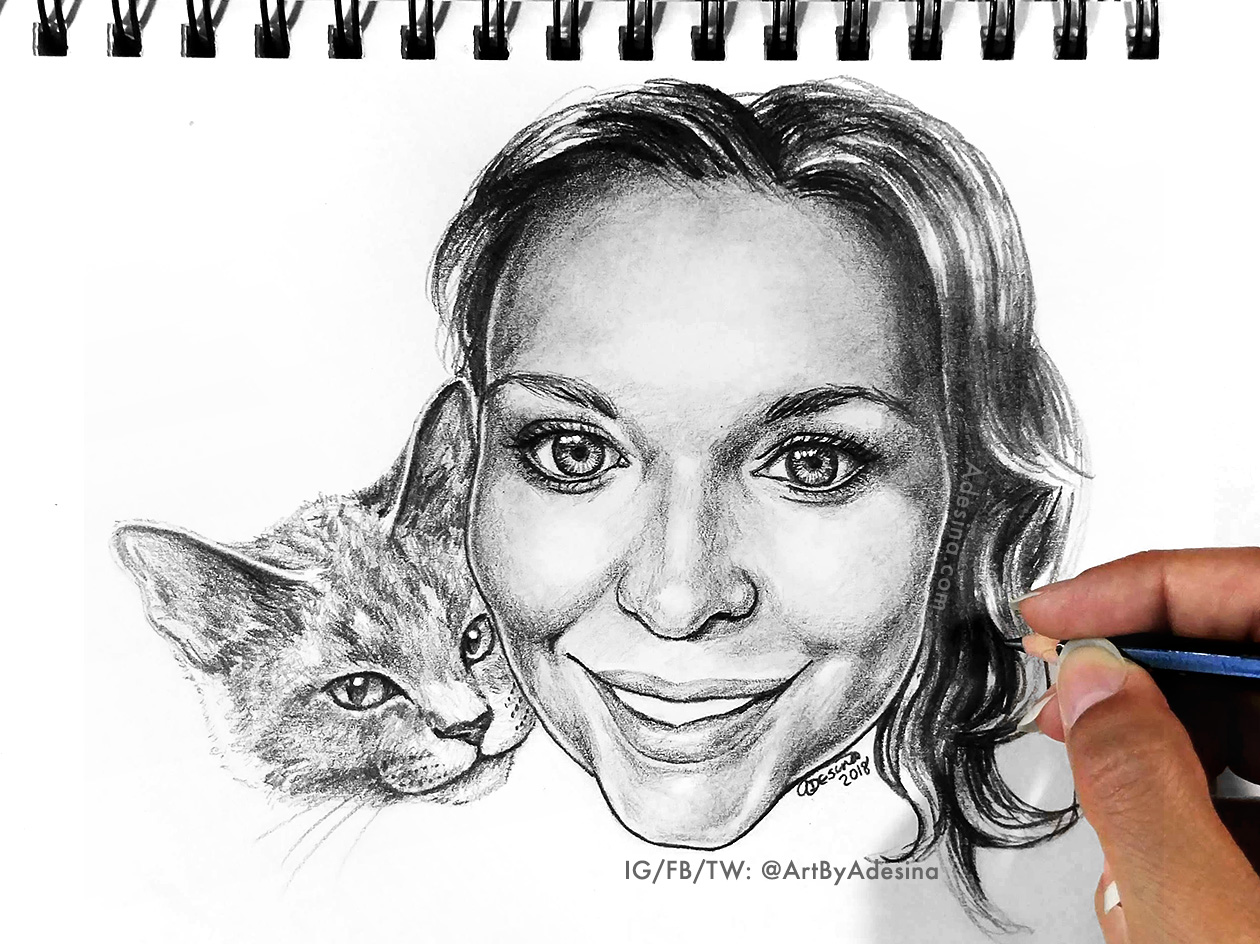 Drawing of a woman and her cat, by Artist Adesina
Drawing of a woman and her cat, by Artist AdesinaIn cases like these, get in touch, send them an email, and just ask: Would they like to do something in the style of, or in regards to the subject matter, that you are looking for? Do they have any relevant samples that are not on their site yet, that they can share via email? In many cases, the artist will be happy for your interest and inquiry, and even if they can’t create what you need, often artists can recommend colleagues who can. Take advantage of their network and recommendations; you might find the perfect person, without having to do endless searching!
Once you find an artist whose work and style you appreciate or connect with, then you can move to the next step.
It helps to connect with the artist you wish to commission, and find out if they do commissions to begin with. Further, different artists have different work parameters or boundaries. There may be some that appreciate a little direction, and others who would rather you left the art to them.
Figure out what you prefer, and find out if the artist and you are on the same plane.
In my studio, for example, I always ask that the client provide images of the style, indicating the level of detail, as well as the level of realism or lack thereof, that they are looking for. Clients can pick from my online gallery at Adesina.com, or they can just Google general images, and send me the ones they like.
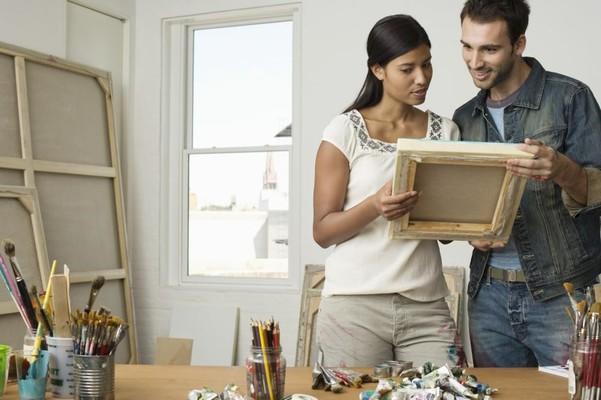
You will need to give the artist you commission some information, even if they are the independent sort. Things you might want to consider include what you’re looking for by way of size, preferred shades or colors, as well as themes to work on (if that is an option).
Giving the artist a sense of what you’re looking for will help them proceed to create the work you want to see.
Once you and the artist are on the same page about the work you’re commissioning, the artist will quote a figure. Typically, you will probably need to pay them part of the figure as an advance for materials and initial payment, to begin your commissioned piece.
If you’re having someone do a live portrait of you instead of from photos, you’ll need to coordinate and schedule sessions and sittings where you model for the artist. Make sure you pick an artist who isn’t too far away! Unless of course you want to make a trip of it — perhaps a vacation/portrait-painting-trip to New York City?
When the artist finishes working on the piece you have commissioned, you will be asked to make one last payment. This will probably be the balance remaining from the quote provided when you began the process. Once this payment is made, voila! You have your first commissioned piece of work!
As you can see, commissioning a piece of work is fairly easy if you have the resources. It’s finding the right artist that’s key to a great outcome. But by taking the first step and just reaching out to an artist that you like, they may be able to help guide you to refine your project idea, and to find the right artist for you, even if they can’t help you out themselves, saving you lots of time and energy!
If you want to commission and own your first personal piece of art, feel free to circle back to my webpage Adesina™ | Artist. I’m in the midst of preparing for a solo show, but I’m still accepting select small commissions (black and white drawings and small sculpted heads) thru the end of 2018, after which all commissions will be available again! You might even find something you like in my collection of affordable art prints, ceramics and sculpture. Alternatively, get in touch and let’s talk about what you’re looking for – I love to help!
– Adesina, Artist